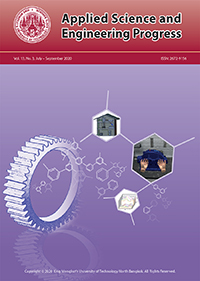Virtual Reality Technology for Maintenance Training
Main Article Content
Abstract
This paper is part of a bigger research project that aims at establishing an integrated VR environment for preparing, evaluating, and executing maintenance training in virtual environments. In order to apply the virtual reality technology to maintenance task training, this paper presents a Virtual Reality for Training in Maintenance Task (VR-TMT) platform using the simulation of the process of a gearbox disassembly and assembly as an example. The system setup and configuration are presented in detail, as well as the analysis of the experience, perception level and side effects of using VR devices. The results show that the user experience and perception levels on provided by the VR-TMT platform are on a good level. In addition to that, the VR-TMT system is easy to use, understand and flexible for transport. Users can therefore profit from the VR-TMT platform to train anywhere and anytime according to their needs. The majority of the experimental users experienced only few side effects, in particular both physical and visual tiredness. However, the experiment confirmed that the immersive experience of VR-supported maintenance task training outweighs the reported side effects.
Article Details
References
[2] X. Liu, X. Cui, G. Song, and B. Xu, “Development of a virtual maintenance system with virtual hand,” The International Journal of Advanced Manufacturing Technology, vol. 70, Issue 9–12, pp. 2241–2247, Feb. 2014.
[3] S. Adulkasem, A. Suwanapech, N. Phongsai, and O. Chaowalit, “System prototype of control and management machine and spare part: A case study of sugar manufacturing plant,” E-Journal Science and Technology Silpakorn University, vol. 2, no. 2, pp. 89–101, 2015.
[4] E. D. Ragan, D. A. Bowman, R. Kopper, C. Stinson, S. Scerbo, and R. P. McMahan, “Effects of field of view and visual complexity on virtual reality training effectiveness for a visual scanning task,” in Proceedings IEEE Transactions on Visualization and Computer Graphics, 2015, vol. 21, no. 7, pp. 794–807.
[5] D. Zhou, X.-X. Zhou, Z.-Y. Guo, and C. Lv, “A maintenance time prediction method considering ergonomics through virtual reality simulation,” SpringerPlus, vol. 5, pp. 1–22, Aug. 2016.
[6] B. Arendarski, W. Termath, and P. Mecking, “Maintenance of complex machines in electric power systems using virtual reality techniques,” in Proceedings Conference Record of the 2008 IEEE International Symposium on Electrical Insulation, 2008, pp. 483–487.
[7] B. Rice. “The future of safety training enhanced by virtual reality,” 2017. [Online]. Available: https://pixovr.com/virtual-reality-future-safetytraining/
[8] D. Corvaglia, “Virtual training for manufacturing and maintenance based on Web3D technologies,” in Proceedings LET-WEB3D 2004 Workshop on Web3D Technologies in Learning, Education and Training, 2004, pp. 28–32.
[9] Z. Guo, C. Lv, D. Zhou, and Z. Wang, “Humancomputer interaction in immersive virtual maintenance,” in Proceedings 12th World Congress on Intelligent Control and Automation (WCICA), 2016, pp. 2567–2573.
[10] F. Ganier, C. Hoareau, and J. Tisseau, “Evaluation of procedural learning transfer from a virtual environment to a real situation: A case study on tank maintenance training,” Ergonomics, vol. 57, no. 6, pp. 828–843, Mar. 2014.
[11] K. Weijun, Y. Xiao, and Z. Lin, “Research of nuclear power plant in-service maintenance based on virtual reality,” Journal of Nuclear Engineering and Radiation Science, vol. 2, no. 4, pp. 1–6, Oct. 2016.
[12] F. Lin, L. Ye, V. G. Duffy, and C.-J. Su, “Developing virtual environments for industrial training,” Information Sciences, vol. 140, no. 1–2, pp. 153– 170, Jan. 2002.
[13] Y. Vélaz, J. R. Arce, T. Gutiérrez, A. Lozano- Rodero, and A. Suescun, “The influence of interaction technology on the learning of assembly tasks using virtual reality,” Journal of Computing and Information Science in Engineering, vol. 14, no. 4, pp. 1–9, Dec. 2014.
[14] R. Raheja, “Training simulations in railroad: Improving maintenance efficiency, streamlining compliance training,” 2019. [Online]. Available: https://hwd3d.com/blog/training-simulations-inrailroad- 3d-vr-ar/
[15] T. S. Mujber, T. Szecsi, and M. S. J. Hashmi, “Virtual reality applications in manufacturing process simulation,” Journal of Materials Processing Technology, vol. 155–156, pp. 1834– 1838, Nov. 2004.
[16] Unity User Manual, “Unity User Manual (2019.3),” 2019. [Online]. Available: https://docs. unity3d.com/Manual/index.html
[17] E. Matsas and G.-C. Vosniakos, “Design of a virtual reality training system for human– robot collaboration in manufacturing tasks,” International Journal on Interactive Design and Manufacturing, vol. 11, pp. 139–153. Feb. 2015.
[18] J. Guna, G. Jakus, M. Pogačnik, S. Tomažič, and J. Sodnik, “An analysis of the precision and reliability of the leap motion sensor and its suitability for static and dynamic tracking,” Sensors, vol. 14, pp. 3702–3720. Feb. 2014.


